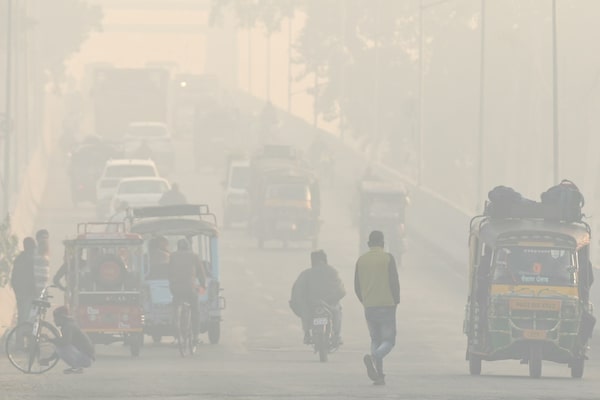
Commuters make their way along a road amid heavy smoggy conditions on the outskirts of Amritsar on Dec. 13.NARINDER NANU/Getty Images
The agreement reached at the end of the COP28 climate summit has raised the floor, in terms of minimal expectations for reducing global reliance on the fossil fuels overheating the planet.
Those expectations are set in a sentence that calls for “transitioning away from” energy sources such as oil and gas “in a just, orderly and equitable manner … so as to achieve net zero by 2050 in keeping with the science.”
It doesn’t exactly leap out as bold. But it’s about as much as anyone familiar with the formal negotiating process at the annual United Nations conference could have reasonably expected.
As for setting the levels of ambition required to contain rising temperatures to a noncatastrophic level, the world will have to look elsewhere – including to some of the more unofficial agreements and discussions that were happening around the sprawling event in Dubai.
Such ambition was more evident in aspects of the closing deal, announced on Wednesday morning, that don’t directly address fossil fuels. They include goals to triple global renewable energy capacity and double the rate of energy efficiency improvements by 2030.
But there is a difference between setting targets around new investments in clean technologies, which offer opportunity to pretty much every country, and embracing the end of entire industries around which some countries are much more reliant than others.
And that reality was always going to stand in the way of the clearer commitment to phase out fossil fuels that climate activists (and governments of countries that don’t have big oil and gas reserves) were seeking.
The talks at the heart of each edition of COP operate on a consensus basis, more or less requiring each of nearly 200 participating counties to accept each major item included in the closing deal.
So it’s best seen as setting a lowest common denominator, acceptable to resisters and laggards.
That makes it remarkable that even the watered-down language around fossil-fuel transition made it through, after opposition from petrostates such as Saudi Arabia (the world’s largest exporter of oil) seemingly had the negotiations on the brink of collapse. It’s all the more so since another petrostate, the host United Arab Emirates – which seemed to spend the conference teetering between backing and resisting energy transition – had to play a mediating role to get the deal over the finish line.
Pledges in COP agreements are not binding. But past commitments, most obviously the broad national emissions-reductions commitments made in Paris in 2015 and in Glasgow in 2021, have proven difficult to ignore. They send signals to investors, they create peer pressure, and countries need to show progress toward them to avoid reputational harm.
So it should now be a little more difficult for oil and gas economies – including Western Canadian provinces – to proceed as though an eventual decline in the industry can be avoided simply by investing in technologies to make production more sustainable, despite the bulk of emissions happening when fuels are consumed.
On its own, that still makes for a rather underwhelming outcome to the summit – particularly because it doesn’t bring much urgency to near-term measures.
But if COP28 is to have major impact in that regard, it’s more likely to come from the array of plans advanced over the course of the conference’s two weeks, which did not require nearly every national government in the world to sign on.
Probably the most tangibly consequential development was the commitment of nearly US$800-million by rich countries to a loss and damages fund for developing countries, which are disproportionately bearing climate change’s effects despite contributing relatively few emissions themselves. It built off a promise negotiated at last year’s COP27 to establish the fund, but the capitalization was kick-started by a pair of governments – Germany and the host United Arab Emirates – pledging US$100-million each (Canada pledged about US$12-million.)
That money won’t go directly toward decarbonization. But it’s a crucial start toward addressing a growing rift between the Global North and the Global South that threatens to impede collective action.
Then there are agreements between groups of countries – and in some cases the private sector – to jointly pursue certain forms of emissions reduction. They tend to have more ambitious goals than possible through the formal proceedings, and seem to be where Ottawa has put a lot of its energy.
The most oft-cited example of that sort of progress came on methane. A global pledge to reduce emissions of that powerful greenhouse gas by at least 30 per cent from 2020 levels by 2030 gained a bunch of new signees, bringing the total to 155 countries.
Canada (along with the United States) showed leadership by unveiling new draft regulations to cut methane leaks from its oil and gas sector 75 per cent from 2012 levels by decade’s end. And that industry itself got in on the act, with 50 companies from around the world pledging to end routine flaring (a major methane source) by 2030, as part of an oil and gas decarbonization charter.
Similar momentum was accrued on ending coal power, as a coalition committed to not building any more coal plants and phasing out existing ones took on new members. Among them was the U.S., which had previously resisted.
Other shared commitments involved smaller numbers of countries, or were bilateral. Canada and the U.S., for instance, issued a joint statement during the conference’s final days asserting their mutual pursuit of a range of targets – among them having clean electrical grids by 2035, harmonized standards to support electric-vehicle adoption, and building carbon-capture and carbon-removal industries.
Even if some of these pledges involve measures already under development back home, they have their value.
The more company that countries have, in pursuing strategies that involve some degree of economic upheaval, the more insulation from domestic backlash.
And most of the agreements involve promises to share information, which means learning from each other’s successes and failures – possibly the most useful thing the world’s environment ministers can do when they all show up in the same place at once.
None of this will sway critics who dismiss COP as a lot of talk, and not enough action.
The conference is by nature guilty of that accusation – even aside from the way that its negotiating process encourages compromise – since actual policy for sovereign countries can’t be set by international fiat.
Any real impact only happens after governments’ representatives return home.
This time, they will do so with higher bars to clear – though just how much higher will depend on which of the agreements struck in Dubai they’re trying to meet.
 Adam Radwanski
Adam Radwanski